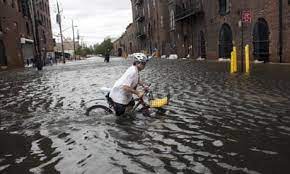On September 7, 2011, the United States East Coast experienced major flooding due to the impact of Hurricane Irene. This natural disaster caused widespread damage, disrupted daily life, and highlighted the vulnerability of coastal communities to extreme weather events. Hurricane Irene, a powerful Category 3 storm, made landfall in North Carolina on August 27, 2011, before moving up the East Coast. As it traveled, the storm brought heavy rainfall and strong winds, causing rivers to overflow and coastal areas to flood. The effects of the storm were felt from North Carolina all the way up to New England. The flooding that occurred as a result of Hurricane Irene was particularly severe in low-lying areas and regions near rivers. The excessive rainfall overwhelmed drainage systems and caused rivers to breach their banks, leading to widespread inundation. Major cities such as New York City, Philadelphia, and Washington, D.C. were among the affected areas. The flooding had a significant impact on daily life in these regions. Many streets and highways became impassable, disrupting transportation and causing traffic jams. Public transportation systems were also severely affected, with subway lines and train services suspended or delayed. In some cases, entire neighborhoods were submerged, forcing residents to evacuate their homes and seek temporary shelter. The economic impact of the flooding was substantial. Businesses were forced to close, resulting in lost revenue and financial hardship for many. Agriculture was also severely affected, with flooded fields and destroyed crops leading to significant losses for farmers. The cost of infrastructure repairs and cleanup efforts ran into billions of dollars. The flooding also exposed the vulnerability of coastal communities to the impacts of climate change and sea-level rise. Rising sea levels, combined with more intense rainfall events, increase the risk of flooding in these areas. The events of September 7, 2011, served as a stark reminder of the need for improved infrastructure, better urban planning, and enhanced resilience measures to mitigate the impacts of future extreme weather events. In response to the flooding, emergency management agencies and local authorities worked tirelessly to provide assistance and support to affected communities. Evacuation orders were issued in high-risk areas, and emergency shelters were set up to accommodate displaced residents. Search and rescue operations were conducted to ensure the safety of those trapped by the floodwaters. The flooding also prompted a broader conversation about climate change and the need for proactive measures to address its impacts. It highlighted the importance of investing in infrastructure that can withstand extreme weather events and adapting urban planning to account for rising sea levels. The event served as a wake-up call for policymakers, urging them to prioritize climate resilience and take action to protect vulnerable communities. The major flooding that occurred on September 7, 2011, along the United States East Coast due to Hurricane Irene was a significant event that had far-reaching consequences. It disrupted daily life, caused extensive damage, and underscored the urgent need for climate resilience measures. The event serves as a reminder of the increasing frequency and intensity of extreme weather events and the importance of proactive measures to mitigate their impacts.
7 Sept, 2011 Major Flooding US East Coast
